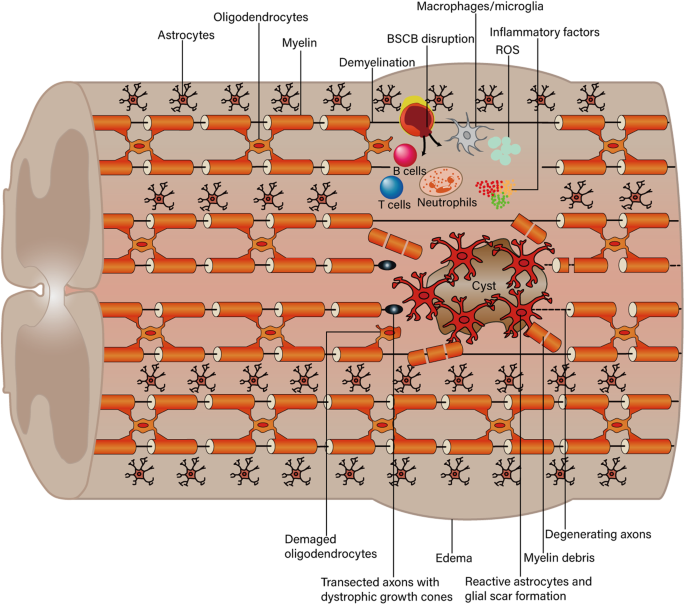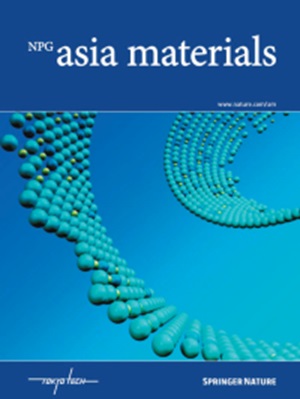基于生物材料的脊髓损伤再生治疗策略
IF 8.3
2区 材料科学
Q1 MATERIALS SCIENCE, MULTIDISCIPLINARY
引用次数: 0
摘要
作为最棘手的神经系统疾病之一,脊髓损伤(SCI)通常会导致患者永久性神经功能损伤。遗憾的是,由于其复杂的病理机制和独特的损伤后微环境,目前还没有完全修复损伤脊髓的方法。近年来,随着组织工程技术的飞速发展,生物材料与医学的结合为治疗 SCI 提供了新的思路。在此,我们系统地总结了具有代表性的生物材料,包括天然材料、合成材料、纳米材料和混合材料,以及它们在 SCI 治疗中的应用。此外,我们还介绍了几种最先进的组织工程制造技术。重要的是,我们为使用基于生物材料的治疗策略减少二次损伤和促进修复提供了新的见解。最后,我们讨论了几项生物材料临床研究。本综述旨在为脊髓再生策略的未来探索提供参考和新见解。本文章由计算机程序翻译,如有差异,请以英文原文为准。


Biomaterial-based regenerative therapeutic strategies for spinal cord injury
As one of the most intractable neurological diseases, spinal cord injury (SCI) often leads to permanent neurological impairment in patients. Unfortunately, due to the complex pathological mechanisms and unique postinjury microenvironment, there is currently no way to completely repair the injured spinal cord. In recent years, with the rapid development of tissue engineering technology, the combination of biomaterials and medicine has provided a new idea for treating SCI. Here, we systematically summarize representative biomaterials, including natural, synthetic, nano, and hybrid materials, and their applications in SCI treatment. In addition, we describe several state-of-the-art fabrication techniques for tissue engineering. Importantly, we provide novel insights for the use of biomaterial-based therapeutic strategies to reduce secondary damage and promote repair. Finally, we discuss several biomaterial clinical studies. This review aims to provide a reference and new insights for the future exploration of spinal cord regeneration strategies. Biomaterial fabrication techniques and therapeutic strategies for spinal cord injury. This review focuses on the most recent advancements of biomaterial-based therapeutics for the treatment of spinal cord injury. The outer ring of the figure shows four fabrication techniques for tissue engineering: hydrogel, electrospinning, 3D printing and decellularization. The inner ring shows the injured spinal cord and the roles of biomaterials in spinal cord injury repair, for instance, restoring the blood‒spinal cord barrier (BSCB). Spinal cord injuries disrupt the pathways that allow the brain to communicate with the body, often resulting in paralysis and loss of sensation below the injury site. Despite advances in care, we still lack definitive treatments to fully restore function after SCI. This study focuses on the potential of biomaterials to aid in spinal cord repair. The results of these experiments have shown promise, with some materials supporting nerve growth and reducing inflammation at the injury site. However, the translation of these findings into human treatments requires further study to ensure safety and effectiveness. In conclusion, the research advances our understanding of how biomaterials can be used to promote spinal cord repair. The potential future implications of this work include the development of new treatments that could improve the quality of life for individuals with SCI. This summary was initially drafted using artificial intelligence, then revised and fact-checked by the author.
求助全文
通过发布文献求助,成功后即可免费获取论文全文。
去求助
来源期刊

Npg Asia Materials
MATERIALS SCIENCE, MULTIDISCIPLINARY-
CiteScore
15.40
自引率
1.00%
发文量
87
审稿时长
2 months
期刊介绍:
NPG Asia Materials is an open access, international journal that publishes peer-reviewed review and primary research articles in the field of materials sciences. The journal has a global outlook and reach, with a base in the Asia-Pacific region to reflect the significant and growing output of materials research from this area. The target audience for NPG Asia Materials is scientists and researchers involved in materials research, covering a wide range of disciplines including physical and chemical sciences, biotechnology, and nanotechnology. The journal particularly welcomes high-quality articles from rapidly advancing areas that bridge the gap between materials science and engineering, as well as the classical disciplines of physics, chemistry, and biology. NPG Asia Materials is abstracted/indexed in Journal Citation Reports/Science Edition Web of Knowledge, Google Scholar, Chemical Abstract Services, Scopus, Ulrichsweb (ProQuest), and Scirus.
 求助内容:
求助内容: 应助结果提醒方式:
应助结果提醒方式:


